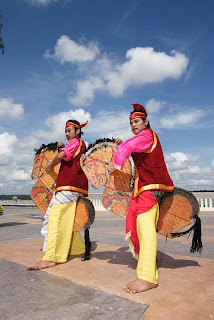Feel free to visit
Monday, 5 November 2012
Saturday, 3 November 2012
Rubber Leaves
 Rubber Tree is very popular at rubber plantation for rubber industry in South East Asia. The Rubber Tree Leaves have 12-15 pairs of side-veins and a further network of very fine veins. This delicate venation and the ability of the leaf to disintegrate in water gives good benefit to create rich appearance of skeleton leaves which will be utilized as a attractive decoration of handicraft goods.
Rubber Tree is very popular at rubber plantation for rubber industry in South East Asia. The Rubber Tree Leaves have 12-15 pairs of side-veins and a further network of very fine veins. This delicate venation and the ability of the leaf to disintegrate in water gives good benefit to create rich appearance of skeleton leaves which will be utilized as a attractive decoration of handicraft goods.Friday, 2 November 2012
Wau Bulan Kelantan
 Wau bulan (moon-kite) is an intricately designed Malaysian moon-kite (normally with floral motifs) that is traditionally flown by men in the Malaysian state of Kelantan. It is one of Malaysia's national symbols, some others being the kris and hibiscus. The reverse side of the fifty-cent coin of Malaysia (1989 series) features an intricately decorated wau bulan with a hummer on top. The logo of Malaysia Airlines (MAS) is also based on this kite.
Wau bulan (moon-kite) is an intricately designed Malaysian moon-kite (normally with floral motifs) that is traditionally flown by men in the Malaysian state of Kelantan. It is one of Malaysia's national symbols, some others being the kris and hibiscus. The reverse side of the fifty-cent coin of Malaysia (1989 series) features an intricately decorated wau bulan with a hummer on top. The logo of Malaysia Airlines (MAS) is also based on this kite.Sabah Pearl

A pearl is a hard object produced within the soft tissue (specifically the mantle) of a living shelled mollusk. Just like the shell of a clam, a pearl is made up of calcium carbonate in minute crystalline form, which has been deposited in concentric layers. The ideal pearl is perfectly round and smooth, but many other shapes of pearls (baroque pearls) occur. The finest quality natural pearls have been highly valued as gemstones and objects of beauty for many centuries, and because of this, the word pearl has become a metaphor for something very rare, fine, admirable, and valuable.
Thursday, 1 November 2012
Songket Terengganu
 Much documentation is sketchy about the origins of the songket but it is most likely that songket weaving was brought to Peninsular Malaysia through intermarriages between royal families. This was a common occurrence in the 15 th century for sealing strategic alliances. These royal women would bring along their personal weavers with their entourage.
Much documentation is sketchy about the origins of the songket but it is most likely that songket weaving was brought to Peninsular Malaysia through intermarriages between royal families. This was a common occurrence in the 15 th century for sealing strategic alliances. These royal women would bring along their personal weavers with their entourage.
Although the term menyongket means 'to embroider with gold or silver threads', the Malay songket is not embroidered. The songket utilises an intricate supplementary weft technique where gold threads are woven in between the longitudinal silk threads of the background cloth. This rich and luxurious fabric demonstrated the social structure of the Malay elite.
Labu Sayong

The traditional art of pitcher making has been around for many years, but this industry is still very much alive in selected areas of Peninsula Malaysia.
These pitchers showcase he beauty of Malaysia's heritage and most of creations can be attributed to the skill and natural talent of the women folk.
The art of pitcher making involves the shaping of clay, which is then printed with various designs, smoked and baked to form a handicrafts which is lots beautiful and unique.
Langkawi Crystal Blowing

A few years ago, two Malaysians traveling across Italy chanced upon an island of glassmakers off the coast o Venice. Fascinated by the intricacies of cyrstal-making, and convinced that Malaysians had a unique contribution to make to the art, they began toying with the idea of seting up a similar operation at home.In 1996, LangkawiiCrystaal was established on the northwestern Malaysian island of Langkawi.
Wednesday, 31 October 2012
Copper
Saturday, 27 October 2012
Saturday, 13 October 2012
Variety Souvenir
Hello there!
We are offering variety of souvenir, just for you!
Please have a look at our blog. Thank you very much.
We are offering variety of souvenir, just for you!
Please have a look at our blog. Thank you very much.
Subscribe to:
Comments (Atom)






